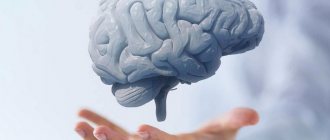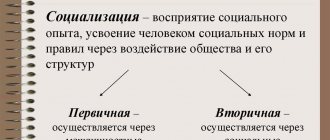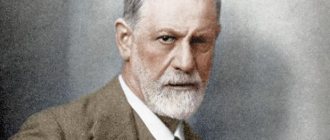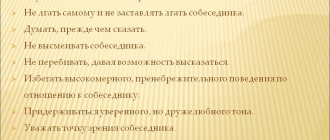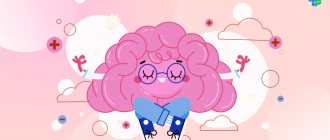Human memory is structured in an interesting way. You may remember completely unnecessary information, but forget something important. In this regard, memory directly serves the motives and needs of a person. At the same time, a person’s head seems to have a lot of drawers - for long-term storage, for quick use, and so on.
Everything is like in the Soviet film “Gentlemen of Fortune”: “I remember here, I don’t remember here.” For certain reasons, such “memory lapses” also happen, as in this funny movie. And there are such miracles of memorization as phenomenal memory. Or the peculiarities of memory functioning in old age in people - when they remember down to the smallest detail their childhood, smells and sounds, but they don’t remember whether they took their medications this morning.
In this article:
How is information recorded?Memory levelsTypes of memoryTypes of memory
How is information recorded?
Image by Gerd Altmann from Pixabay
How does this miracle mechanism work? Just events, just sensations, emotions. And they change the structure of the brain! Neurophysiologists will tell you how. One of the widespread chemical theories of memory is Hiden's hypothesis about the protein nature of memory. He came to the conclusion that the RNA of brain cells is associated with memory, i.e. The memory mechanism is a change in RNA structure.
All information that the human brain perceives is encoded. A chemical reaction occurs, the structure of RNA molecules changes. Basic neural connections are formed. These are “paths” along which the nerve impulse will then habitually “travel”.
Protein plays an important role in this process. That is why the memory of a healthy person is better than that of an elderly person or one weakened by illness. Prevention of excellent memory - brain training and good nutrition. We will tell you how to train your memory in this article.
Visual memory disorders
When visual memory is impaired, the time and number of visual images that can be retained in it are reduced.
Some memory impairments occur in the following diseases:
- Alzheimer's disease;
- vascular pathologies (hypertension, atherosclerosis),
- encephalitis and other infections;
- dyslexia (inability to master reading skills);
- addiction;
- stroke;
- head injuries;
- alcoholism;
- stress;
- overwork;
- brain tumors;
- some somatic diseases;
- disruption of nucleic acid metabolism, especially RNA;
- insufficient maturity of certain nervous structures of the brain or visual analyzers or disturbances in their functioning.
In difficult cases, diagnosing visual memory may require consultation with a neurologist, ophthalmologist, psychologist, speech therapist, or speech pathologist.
Memory levels
In the classification of memory, types, types and levels are distinguished. P.P. wrote about memory levels. Blonsky. He called them genetic levels of memory.
Processes and types of memory
- The first level is motor memory. It is formed first. This is the memory of movements and bodily sensations.
- The second level is affective memory. This is the level of emotions, feelings. These are the first experiences of a person. They are closely related to bodily sensations. This is a person's sensory experience.
- The third level is figurative (mainly visual) memory. As the brain and nervous activity develop, a person becomes able to remember information transmitted by the visual channel. These are the first images in a person’s memory.
- The fourth level is verbal memory. This level is formed along with the appearance of speech and its development.
The division into these levels is quite arbitrary, but this is approximately how the development of human memory works - from the simplest structures to the most complex. Subsequently, these levels overlap each other and exist together. They continue their development: a person is able to remember more and more complex motor combinations, affects develop into emotions and more complex feelings, visual and verbal memory develops.
Gradually the child learns to roll over, sit up, and crawl. His body remembers new combinations of movements and his behavior becomes more varied than reflex actions. The child also learns to distinguish between his mother’s emotions, learns to grimace himself, and in his crying you can hear different emotional shades: when he is hungry, or when he is scared, and when he is happy.
Visual memory allows a child to learn to remember objects and the surrounding environment. He remembers his loved ones and distinguishes between strangers. The development of verbal memory helps the baby master sounds and new words. He remembers the speech and tries to reproduce it.
Figurative memory
Figurative memory is a repository of sounds, smells, and visual ideas. Visual-figurative memory stores material in the form of visual, auditory and other images. Therefore, several separate types of figurative memory are distinguished, such as auditory (try to remember the purring of a kitten or the crackling of brushes in a fire), visual figurative memory (the face of a loved one or a favorite vase - remember?), olfactory (the smell of a familiar perfume or just freshly cut grass), tactile (the touch of a warm hand or the pain of an injection), taste (the sourness of a slice of lemon or the sweetness of a banana). Visual-figurative memory is especially important in creative activity.
Our brain prefers to perceive the world by processing information in both hemispheres: the right one perceives the image, and the left one selects words for it. By developing figurative memory, we fill the gap caused by the lack of images: in the modern world there is a lot of information, but the bulk of it does not involve the right hemisphere in its work, an imbalance arises, as a result of which it is increasingly difficult for us to remember, maintain attention, and concentrate. The development of figurative memory helps to engage the right hemisphere, using the imagination. By imagining, we remember easily. Having understood the material, we create an image that consolidates understanding and gain knowledge.
There are visual, auditory, motor-auditory memory, visual-motor-auditory memory. These are the types of so-called sensory memory that play the most important role in learning. Knowing what type of memory predominates in a student, you can take a differentiated approach to the process of his learning, achieving better memorization results. The teacher must ensure that as many senses as possible participate in the process of learning the material. At one time, the famous teacher K.D. drew attention to this. Ushinsky.
Memory types
The differentiation of memory types is related to how the sensory area serves as the best basis for retrieval. Some people remember visual data better, others – auditory data, and others – motor data. One person, in order to remember, must read the text himself, and in his memory a predominantly visual image is restored; for another, the same predominant role is played by auditory perceptions and ideas; the third has motor skills: the text is best consolidated for him through writing.
Pure types are rare, and mixed types are usually observed: visual-motor, motor-auditory and visual-auditory types of memory. The most common type of memory is visual. For example, while taking an exam. Some students clearly remember pages from textbooks. When they remember the desired text, they have an image of this page before their eyes, they can even name the paragraph and page number. And someone will remember that there was a drawing in the margins of the textbook.
Giphy
An example of a developed visual-motor memory is a student who writes cheat sheets all night but never uses them. There are two channels at work here - while he is writing the text, his hands “remember” the movement, information is stored thanks to the action. And at the same time, he visually remembers the text he writes. This becomes enough to reproduce the necessary information.
With developed motor-auditory memory, a person needs to read a text aloud and at the same time, for example, walk. Or make some short notes or notes. Or listen to an audio recording of the text and take notes. The most striking example is when a person feels more comfortable listening to an audiobook while walking or cleaning the house.
Memory is also differentiated by the nature of the best remembered material. A good memory for colors can be combined with a poor memory for numbers and vice versa. Memory for visual-figurative and abstract content, for mathematical formulas and for emotional experiences can be different. All features of perception and thinking, sensory and emotional spheres appear within memory.
Development of visual memory
Visual memory is trained and developed during its active use. It is formed in childhood, but it can be developed and trained throughout life.
To develop visual memory, you can use short training sessions or your hobbies:
- Reading. Develops information memorization skills, enriches vocabulary and improves intellectual abilities.
- Drawing. In addition to developing imagination, perseverance, and creativity, this activity will help develop visual memory if you reproduce a familiar object or place on paper, trying to achieve photographic accuracy. Illustrating complex patterns, such as veining in marble, is a very effective way to develop visual memory.
- Novelty. The essence of this training method is to regularly do something unusual, to move away from familiar ways, methods of performing actions and routes. It could just be new places, people, routes in your hometown, performing familiar actions in a new way .·
- Memories. Before going to bed, you need to remember in detail all the events of the past day in chronological order.
- Portrait. You need to remember exactly what a specific person looks like. It is best to use the exercise on familiar people first, and as you practice, you can move on to strangers.
- Examination of the subject. For a few minutes you need to carefully examine an object that you rarely come into contact with in everyday life. After this, with your eyes closed, mentally imagine the object you saw with maximum accuracy and correctness. .
- Solving mindfulness problems. Finding differences in pictures develops attention to detail and develops composition memorization skills.
- Development of synesthesia. This term denotes a memorization technique in which visual elements are associated with sound, taste, olfactory, and tactile elements. Synesthesia stimulates the nervous structures of one sensory system to activate the structures of another (for example, this principle of memorization is the basis for naming subway lines by color, and not by the names of the outermost stations).
- Using a verbal description of an object to facilitate its visual memorization, that is, it is necessary to remember the image as a sequence of words. Speaking retains the details of the image seen in visual memory.
Types of memory
The division of memory into types has something in common with memory levels. Types of memory are differentiated depending on what is remembered or reproduced. So, they distinguish:
Image by Here and now, unfortunately, ends my journey on Pixabay from Pixabay
- Memory of movements and actions (motor). When you reproduce some familiar actions, skills;
- Figurative memory: visual, auditory, tactile, etc.
- Logical (memory for thoughts);
- Affective (memory for feelings).
Each type of memory is like a separate shelf for its own type of information. Some types of memory may be more developed. It depends on your predisposition and lifestyle. If you have a sedentary, mental job, then your motor memory will be less developed than your logical or figurative one. You can train any type of memory by selecting the desired “training program”: memorizing text, or sensations, dance movements, or pictures and images.
There is also a distinction between long-term and short-term memory. In order for this or that material to be fixed in memory, it must be appropriately processed by a person. Such processing requires a certain time, which is called the time of trace consolidation.
This is felt as an echo of an event that just happened: for a moment you seem to continue to see, hear, etc., which you no longer directly perceive (stands before your eyes, sounds in your ears, etc.). These processes are unstable and reversible, but they are so specific and their role in the functioning of the mechanisms of experience accumulation is so significant that they are considered as a special type of memorization, storage and reproduction of information, which is called short-term memory.
Photo taken from open sources
Unlike long-term memory, which is characterized by long-term retention of material after repeated repetition and reproduction, short-term memory is characterized by very short retention. RAM is also allocated. This is the amount of memory that is necessary to process information in the “here and now” mode.
You can also highlight voluntary memory - what you remember consciously, making an effort. And involuntary memory - when something was remembered “by itself” because it was special, bright, relevant for you.
Knowing the capabilities of your brain and such a powerful tool as memory, you can develop your mental abilities.
Memorizing 10 pictures
Pictures are presented one at a time (approximately one picture per second). The subject must reproduce the entire set of pictures at the verbal level (name what is drawn in the pictures). The playback order does not matter. The protocol records the number of correctly reproduced pictures. Then this game for the development of visual object memory needs to be expanded to 16-20 pictures.
Which of the greats had eidetic memory?
Many great people have had the gift of eidetic memory. This helped them keep in mind, combine and analyze a huge variety of different information in the areas of activity in which they were engaged. This quality was extremely useful in an era when personal computers did not yet exist. Here are just a few of these people:
Sergei Rachmaninov, Russian composer and pianist. Having once looked at unfamiliar notes, he could immediately play any complex musical composition with absolute precision.
Nikola Tesla, electrical physicist. I never used notes because I kept everything in my memory.
John Paul II, Pope. Fluent in 21 languages.
Seneca, Roman philosopher. In exact sequence, he recalled from memory two thousand words he read, often not even related in meaning.
Winston Churchill, British politician. Knew all of Shakespeare by heart.
Heinrich Schliemann, archaeologist. I studied any foreign language in a month and a half.
Paul Morphy, chess player. He remembered all the moves of the games he played.
Daniel Tammet. Able to name more than 22 thousand decimal π
Alexander Suvorov, Russian commander. He knew by sight and name every soldier in his army, which consisted of 24 thousand people.
Long-term, short-term and working memory
Based on the time it takes to store information, we distinguish between instant, short-term, operational and long-term memory. Short-term memory is capable of storing information for a very short time, about 40 seconds, and its volume is small, it is 7 plus or minus 2 units of information. This volume can be increased by combining information into blocks.
Most of the information from short-term memory is then erased, and less goes into the so-called working memory. This is facilitated by some factors, such as the emotionality of the presentation, brightness, surprise, unusualness of the material, repeated repetition, and importance for a particular person. Information is stored in RAM for up to a day (maximum), then the less important part is erased, and the more important part goes into long-term memory. Here, information is stored throughout life, and for this the body uses special nucleic acids and memory proteins.
Interestingly, in the slow-wave sleep phase, logical information processing occurs, and in the fast sleep phase, selected information is transferred to long-term memory. You can read more about these processes and the development of long-term memory, as well as the development of short-term memory, in our blog.
History of research
The first studies of memory began in ancient times and were associated with the learning process. In Ancient Greece, for example, it was generally believed that information penetrates a person’s head in the form of specific material particles, leaving imprints on the soft substance of the brain, like clay or wax.
Subsequently, the author of the “hydraulic” model of the nervous system, R. Descartes, formulated the idea that the regular use of the same nerve fibers (hollow tubes, according to Descartes) reduces their resistance to the movement of “vital spirits” (due to stretching). This, in turn, leads to the formation of memorization.
In the 80s 19th century G. Ebbinghaus offers his own method of studying the laws of the so-called pure memory. The technique involved memorizing nonsense syllables. The result was memory curves, as well as certain patterns in the operation of association mechanisms. For example, it was found that those events that made a strong impression on a person are especially firmly remembered. Such information is remembered immediately and for a long time. On the contrary, data that is less significant for a person (even if it is more complex in its content) in memory, as a rule, is not stored for a long time.
Thus, G. Ebbinghaus was the first to apply the experimental method to the study of memory.
Starting from the end of the 19th century onwards, they tried to interpret the memory process by analogy with the functioning of such mechanical devices as a telephone, tape recorder, electronic computer, etc. If we draw analogies with modern technologies, then there is a classification of computer memory.
In the modern scientific school, biological analogies are used when analyzing memory mechanisms. For example, some types of memory are attributed to a molecular basis: the process of imprinting information is accompanied by an increase in the content of nucleic acids in the neurons of the brain.
Memory classification
Psychology relies on the following criteria in identifying types of memory:
1. The nature of the predominant mental activity:
- motor,
- figurative,
- emotional,
- verbal-logical.
2. Nature of activity goals:
- free
- involuntary.
3. Duration of fixing/preserving material:
- short-term,
- long-term,
- operational.
4. Use of mnemonic devices:
- direct,
- mediated.
This is interesting
George Sperling experimentally established in 1960 that auditory memory is one of the basic conditions for storing verbal information and its easy reproduction.
Auditory memory inputs are intraspeech response units held in auditory working memory for only a few moments. Next, a speech response occurs, which helps to return speech sounds to memory. It is this connection that plays a very important role in short-term memorization.
Students in school who are better at processing oral information by ear are called auditory learners, they usually have very good grades and are able to perfectly remember everything that was said in class without looking at notes or textbooks. However, there are only 5-7% of absolute auditory learners in the world; other people perceive information through visual, kinesthetic or discrete sources.
Remember how Shurik in the film “The Adventures of Shurik” turned out to be a real auditory person; he did not remember that he was next to the girl while preparing for the exam, but he remembered that he was already in this room as soon as he heard the sound of the fan and the wall clock.
Who has more developed
It is believed that girls have better visual memory than boys. But there are other factors that provide the best conditions for the development of abilities. To generalize, we can say that those people who constantly use it have a greater volume and quality of memory.
For example, residents of the Far North live in very harsh conditions and are surrounded on all sides by a monotonous, monotonous landscape. But their visual perception often saves them in critical situations, instantly noting the slightest deviations from the usual picture. For example, a shadow flashing in the distance may mean that there is a bear or a hungry wolf pack nearby, and a change in the color of the ice will tell you that you should not step on it - a crack will form there and there is a risk of falling into the icy water.
The same goes for people who constantly deal with various visual information. For example, a scientist will instantly recognize a formula familiar to him, and a car mechanic will “calculate” the cause of a breakdown based on the external state of the engine, because he has already seen such a picture more than once.
Diagnostics
An adult can also pass the test for excellent visual memory if he so desires. But diagnostics in younger schoolchildren and preschoolers reveals disturbances in the processes of perception and assimilation of information.
Preschool-aged children undergo these tests to determine how ready they are for school or to evaluate their progress. Junior schoolchildren are tested to determine their mastery of the information presented in the primary grades. A well-developed memory allows a child to learn better and absorb knowledge much more effectively.
Verbal-logical memory
The verbal-logical type of memory stores information in the form of verbal concepts and numbers. It is responsible for meaning, logic, and interaction between elements of verbal information. In the learning process, both figurative and verbal-logical memory are widely used. Figurative memory is inextricably linked with imagination and is in demand in many areas of human life.
We use the verbal-logical type of memory all the time. When we study new material, it is mainly she who works. The development of all other types of memory in a person also depends on the development of verbal-logical memory: it relies on them and plays a leading role in the assimilation of new knowledge.
It is very important to develop the verbal and logical memory of younger schoolchildren, because, as practice shows, if a child does not master the techniques of mental activity and learn to study (forgive the tautology) in the lower grades, then he will fail in the middle and high grades, falling behind in his studies.
The development of verbal and logical memory helps to improve erudition and increase education. The peculiarity of verbal-logical memory is that thoughts do not exist without the participation of language, without words, and neither does their reproduction. We always work with thoughts expressed in words, hence the name - verbal-logical memory.
